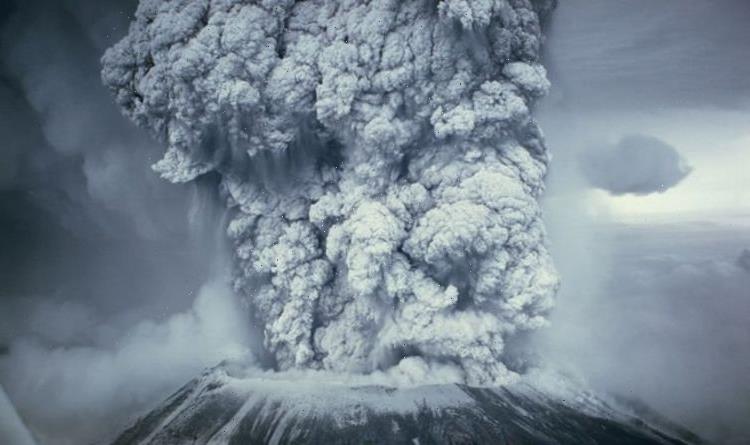Yellowstone Volcano: Super eruptions 'are very rare' says expert
We use your sign-up to provide content in ways you’ve consented to and to improve our understanding of you. This may include adverts from us and 3rd parties based on our understanding. You can unsubscribe at any time. More info
Supervolcano eruptions rock the planet once every 100,000 years on average and though rare, their impacts are far-reaching. When the Toba supervolcano in Indonesia erupted some 74,000 years ago, there is some evidence to suggest it spewed enough ash into the skies to trigger an ice age – a cataclysm humanity only barely managed to survive. It is, therefore, rather worrying to learn there is no universally agreed-upon set of warning signs that precede a supereruption.
Estimates vary but there are about 12 supervolcanoes peppered around the planet – including the world-famous Yellowstone volcano in the western United States.
Writing today (July 27) in Nature Reviews Earth and Environment, a team of scientists has warned trying to predict when any of these volcanoes might erupt is extremely challenging.
The alert follows an in-depth review of 13 supervolcano eruptions over the last two million years, including the relatively recent Oruanui eruption in New Zealand 25,400 years ago.
The scientists found there is no single model for how these eruptions begin and unfold – and that makes predicting future eruptions a problem.
According to the US Geological Survey (USGS), supervolcanoes are volcanoes that have had one or more eruption of magnitude 8 on the Volcanic Eruption Index (VEI).


Eruptions of magnitude 8 and above release more than 1,000 cubic kilometres of material, which is enough to possibly disrupt the climate for decades to come.
During Yellowstone’s three big eruptions between 2.1 million and 640,000 years ago, the volcano released enough ash to cover much of the western half of North America.
It is a good thing then Yellowstone is not about to erupt anytime soon – but what about the other supervolcanoes?
The team of scientists, which includes experts from Cardiff University, found the youngest Toba eruption 74,000 years ago, for instance, was a very abrupt eruption marked by the immediate collapse of the volcano’s chamber roof.
In stark contrast, the Oruanui eruption of New Zealand’s Taupo Volcano was a much slower affair.
The volcano deposited a large blanket of ash before its caldera collapsed and progressed intermittently with a number of pauses over a period of several months.
The amount of magma spewed by the volcanoes also varied from eruption to eruption.
Yellowstone Supervolcano: Expert discusses potential eruption

The scientists consequently believe we need to spend more time monitoring these systems to better understand how they behave now and in the future.
Yellowstone, for example, is very seismically active but geologists are confident this is not an indicator of a brewing eruption.
But could the same be said of the Taupo volcano in New Zealand or the Phlegraean Fields in Italy?
According to study co-author Dr George Cooper, from Cardiff University’s School of Earth and Environmental Sciences, geologists need to understand what is “normal” for these volcanoes so that we are better prepared when they start to exhibit unusual signs of activity.
He told Express.co.uk: “Another supervolcanic system where we see these non-eruptive unrest episodes is Taupo Volcano, New Zealand.
“Recent work using the locations and patterns of earthquakes and ground deformation has allowed scientists to infer the current location of the magma reservoir containing molten rock.


“New magma feeding the reservoir has led to cracking of the surrounding rock (causing earthquakes).
“Therefore, careful monitoring of these systems needs to be carried out to better understand the processes occurring at depth beneath the volcano.
“The more we monitor these systems, the easier it will be to educate the public on what the ‘normal’ situation is.”
Better understanding how these systems behave and may behave in the future could save lives.
Thankfully, there is no reason to believe a supervolcano eruption is waiting to happen just around the corner.
Yellowstone volcano, in particular, often falls prey to misinformation and claims of an imminent disaster – claims scientists fight on an almost daily basis.
Dr Cooper said: “The issue is that these large silicic volcanoes often undergo periods of unrest, consisting of elevated seismicity, ground deformation and gas emissions.
Yellowstone supervolcano can ‘tear guts out of US’ says expert
“However, these are not necessarily signs that the system will erupt.
“Therefore we need to improve our understanding of non-eruptive unrest at these locations, as these events can cause major societal and economic impacts.”
Activity that is well within the norms of volcanic behaviours, such as frequent seismicity, may be interpreted by the public as worrying signs
In the case of Yellowstone volcano, Dr Cooper said more effective education and communication is needed.
The expert believes this will be a “key mitigation strategy against the societal impacts of future unrest episodes.”
But even as scientists call for more research and monitoring into supervolcanic systems, Dr Cooper does not think it will supersede other research carried out in the field.
He added: “Whilst I believe that research into supereruptions is pressing, I don’t think that it supersedes research into smaller volcanic systems.
“What we highlight in the manuscript is that there isn’t one particular set of conditions that cause an eruption to become so huge.
“There is a huge diversity in how these past events operate and many share similarities with smaller, more frequently erupting volcanoes.
“Therefore we can still learn a lot from smaller volcanoes that can help us understand the largest events.
Source: Read Full Article
